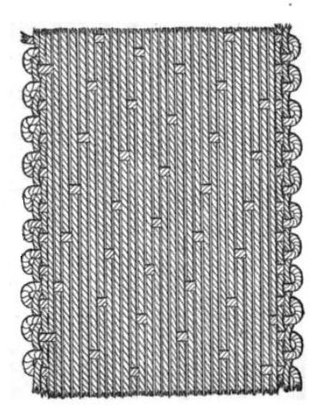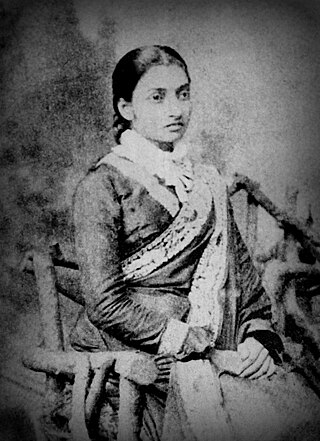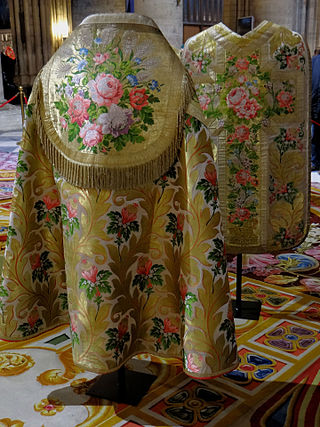Related Research Articles

A loom is a device used to weave cloth and tapestry. The basic purpose of any loom is to hold the warp threads under tension to facilitate the interweaving of the weft threads. The precise shape of the loom and its mechanics may vary, but the basic function is the same.

Velvet is a type of woven fabric with a dense, even pile that gives it a distinctive soft feel. Historically, velvet was typically made from silk. Today, velvet can be made from silk, linen, cotton, wool, synthetic fibers, silk-cotton blends, or synthetic-natural fiber blends.

A satin weave is a type of fabric weave that produces a characteristically glossy, smooth or lustrous material, typically with a glossy top surface and a dull back; it is not durable, as it tends to snag. It is one of three fundamental types of textile weaves alongside plain weave and twill weave.

A sari is a women's garment from the Indian subcontinent. It consists of an un-stitched stretch of woven fabric arranged over the body as a robe, with one end attached to the waist, while the other end rests over one shoulder as a stole, sometimes baring a part of the midriff. It may vary from 4.1 to 8.2 metres in length, and 60 to 120 centimetres in breadth, and is a form of ethnic wear in India, Sri Lanka, Nepal, Bangladesh, and Pakistan. There are various names and styles of sari manufacture and draping, the most common being the Nivi style. The sari is worn with a fitted bodice also called a choli and a petticoat called ghagra, parkar, or ul-pavadai. It remains fashionable in the Indian subcontinent today.
Ikat is a dyeing technique from Southeast Asia used to pattern textiles that employs resist dyeing on the yarns prior to dyeing and weaving the fabric. In Southeast Asia, where it is the most widespread, ikat weaving traditions can be divided into two general groups of related traditions. The first is found among Daic-speaking peoples. The second, larger group is found among the Austronesian peoples and spread via the Austronesian expansion to as far as Madagascar. It is most prominently associated with the textile traditions of Indonesia in modern times, from where the term ikat originates. Similar unrelated dyeing and weaving techniques that developed independently are also present in other regions of the world, including India, Central Asia, Japan, Africa, and the Americas.

Damask is a woven, reversible patterned fabric. Damasks are woven by periodically reversing the action of the warp and weft threads. The pattern is most commonly created with a warp-faced satin weave and the ground with a weft-faced or sateen weave. Yarns used to create damasks include silk, wool, linen, cotton, and synthetic fibers, but damask is best shown in cotton and linen. Over time, damask has become a broader term for woven fabrics with a reversible pattern, not just silks.

Double cloth or double weave is a kind of woven textile in which two or more sets of warps and one or more sets of weft or filling yarns are interconnected to form a two-layered cloth. The movement of threads between the layers allows complex patterns and surface textures to be created.

Jamdani is a fine muslin textile produced for centuries in South Rupshi of Narayanganj district in Bangladesh on the bank of Shitalakhwa river.

Crêpe, also spelled crepe or crape, is a silk, wool, or synthetic fiber fabric with a distinctively crisp and crimped appearance. The term "crape" typically refers to a form of the fabric associated specifically with mourning. Crêpe was also historically called "crespe" or "crisp".

Paithani is a variety of sari, named after the Paithan town in [[Aurangabad district, Maharashtra| Aurangabad] from state of Maharashtra in India where the sari was first made by hand. Present day Yeola town in Nashik, Maharashtra is the largest manufacturer of Paithani.

Kasuri (絣) is the Japanese term for fabric that has been woven with fibers dyed specifically to create patterns and images in the fabric, typically referring to fabrics produced within Japan using this technique. It is a form of ikat dyeing, traditionally resulting in patterns characterized by their blurred or brushed appearance.

Plain weave is the most basic of three fundamental types of textile weaves. It is strong and hard-wearing, and is used for fashion and furnishing fabrics. Fabrics with a plain weave are generally strong, durable, and have a smooth surface. They are often used for a variety of applications, including clothing, home textiles, and industrial fabrics.

In India, about 97% of the raw mulberry silk is produced in the Indian states of Karnataka, Andhra Pradesh, Tamil Nadu and West Bengal. Mysore and North Bangalore, the upcoming site of a US$20 million "Silk City", contribute to a majority of silk production. Another emerging silk producer is Tamil Nadu in the place in where mulberry cultivation is concentrated in Salem, Erode and Dharmapuri districts. Hyderabad, Andhra Pradesh and Gobichettipalayam, Tamil Nadu were the first locations to have automated silk reeling units.
The manufacture of textiles is one of the oldest of human technologies. To make textiles, the first requirement is a source of fiber from which a yarn can be made, primarily by spinning. The yarn is processed by knitting or weaving, which turns it into cloth. The machine used for weaving is the loom. For decoration, the process of colouring yarn or the finished material is dyeing. For more information of the various steps, see textile manufacturing.

Brocade is a class of richly decorative shuttle-woven fabrics, often made in coloured silks and sometimes with gold and silver threads. The name, related to the same root as the word "broccoli", comes from Italian broccato meaning 'embossed cloth', originally past participle of the verb broccare 'to stud, set with nails', from brocco, 'small nail', from Latin broccus, 'projecting, pointed'.

Shot silk is a fabric which is made up of silk woven from warp and weft yarns of two or more colours producing an iridescent appearance. A "shot" is a single throw of the bobbin that carries the weft thread through the warp, and shot silk colours can be described as "[warp colour] shot with [weft colour]." The weaving technique can also be applied to other fibres, such as cotton, linen, and synthetics.

A Sambalpuri sari is a traditional handwoven bandha (ikat) sari wherein the warp and the weft are tie-dyed before weaving. It is produced in the Sambalpur, Bargarh, Balangir, Boudh and Sonepur districts of Odisha, India. The sari is a traditional female garment in the Indian subcontinent consisting of a strip of unstitched cloth ranging from four to nine meters in length that is draped over the body in various styles.

Handloom saris are a traditional textile art of Bangladesh and India. The production of handloom saris is important for economic development in rural India.

Odisha Ikat, is a kind of ikat known as Bandhakala and Bandha, a resist dyeing technique, originating from Indian state of Odisha. Traditionally known as "Bandhakala"', "Bandha", '"Bandha of Odisha", it is a geographically tagged product of Odisha since 2007. It is made through a process of tie-dyeing the warp and weft threads to create the design on the loom prior to weaving. It is unlike any other ikat woven in the rest of the country because of its design process, which has been called "poetry on the loom". This design is in vogue only at the western and eastern regions of Odisha; similar designs are produced by community groups called the Bhulia, Kostha Asani, and Patara. The fabric gives a striking curvilinear appearance. Saris made out of this fabric feature bands of brocade in the borders and also at the ends, called anchal or pallu. Its forms are purposefully feathered, giving the edges a "hazy and fragile" appearance. There are different kinds of bandha saris made in Odisha, notably Khandua, Sambalpuri, Pasapali, Kataki and Manibandhi.

Brocatelle is a silk-rich fabric with heavy brocade designs. The material is characterized by satin effects standing out in relief in the warp against a flat ground. It is produced with jacquard weave by using silk, rayon, cotton, or many synthetic yarns.
References
- 1 2 3 Agrawal, Yashodhara (2003). Silk brocades. New Delhi: Roli Books. p. 65. ISBN 978-81-7436-258-2.
- 1 2 3 Picken, Mary Brooks (1999). A dictionary of costume and fashion : historic and modern : with over 950 illustrations. Mineola, NY: Dover Publications. p. 352. ISBN 978-0-486-40294-9.
- ↑ Indian Trade Journal. Department of Commercial Intelligence and Statistics. 1963. p. 1209. Archived from the original on 7 April 2023. Retrieved 7 April 2023.
- ↑ Hart, Avril (1998). Fashion in detail : from the 17th and 18th centuries. New York: Rizzoli. p. 222. ISBN 978-0-8478-2151-8.
- ↑ Dhamija, Jasleen (1995). The Woven Silks of India. Marg Publications. p. 104. ISBN 978-81-85026-28-2. Archived from the original on 25 April 2023. Retrieved 25 April 2023.
- ↑ King, Brenda M. (3 September 2005). Silk and Empire. Manchester University Press. pp. xviii. ISBN 978-0-7190-6700-6. Archived from the original on 25 April 2023. Retrieved 25 April 2023.
- 1 2 3 4 5 Fairchild's dictionary of textiles. New York: Fairchild Publications. 1959. p. 559.
- ↑ Kadolph, Sara J. (1998). Textiles. Upper Saddle River, N.J.: Merrill. p. 409. ISBN 978-0-13-494592-7.
- ↑ Textiles By Kadolph Sara J Marck. p. 1837.
- ↑ Cumming, Valerie (2010). The dictionary of fashion history. Oxford ; New York: Berg. p. 274. ISBN 978-1-84788-534-0.
- ↑ Hayward, Maria (5 July 2017). Dress at the Court of King Henry VIII. Routledge. p. 205. ISBN 978-1-351-56917-0. Archived from the original on 7 April 2023. Retrieved 7 April 2023.
- ↑ LUSON, Jane (1835). Exhibition of Ancient Female Court Costume ... [By Permission of the Executors of Mrs. Jane Luson.] Third Edition. W. Barnes. p. 19. Archived from the original on 7 April 2023. Retrieved 7 April 2023.
- ↑ Pinhorn), Jane Thomas (née (1858). The London and Paris ladies' magazine of fashion, ed. by mrs. Edward Thomas. Archived from the original on 7 April 2023. Retrieved 7 April 2023.
The mixed tissues of wool and silk are exclusively reserved for negligés .
- 1 2 Baclawski, Karen (1995). The guide to historic costume. New York: Drama Book Publishers. pp. 99, 225. ISBN 978-0-89676-137-7.
- ↑ Elegance in an age of crisis : fashions of the 1930s. New Haven: Yale University Press. 2014. p. 63. ISBN 978-0-300-20420-9.
- ↑ Mohanty, Bijoy Chandra (1984). Brocaded Fabrics of India. Calico Museum of Textiles. p. 29. Archived from the original on 7 April 2023. Retrieved 7 April 2023.
- ↑ General, India (Republic) Office of the Registrar (1964). Census of India, 1961. Manager of Publications. p. 10. Archived from the original on 7 April 2023. Retrieved 7 April 2023.
- ↑ Textiles and Dress of India: Socio-economic, Environmental and Symbolic Significance. University of Minnesota. 1992. p. 254. Archived from the original on 7 April 2023. Retrieved 7 April 2023.
- ↑ Sumathi, G. J. (2007). Elements of Fashion and Apparel Design. New Age International. p. 60. ISBN 978-81-224-1371-7. Archived from the original on 21 April 2023. Retrieved 7 April 2023.
- ↑ Madras Information. Director of Information and Publicity, Government of Madras. 1968. p. 20. Archived from the original on 21 April 2023. Retrieved 7 April 2023.
- ↑ Cultures, Institute of Traditional (1968). Bulletin of the Institute of Traditional Cultures, Madras. University of Madras. p. 339. Archived from the original on 7 April 2023. Retrieved 7 April 2023.
- ↑ Buch, Nidhi; Trivedi, Hetvi (30 December 2021). Geographical Indications of Indian Handlooms: Between Legal Right and Real Right. Taylor & Francis. p. 59. ISBN 978-1-000-52225-9. Archived from the original on 26 April 2023. Retrieved 26 April 2023.
- ↑ "Alia Bhatt is not your quintessential bride in red lehenga but a stunning Sabyasachi dulhan in ivory saree. We love!". India Today. 14 April 2022. Archived from the original on 6 April 2023. Retrieved 6 April 2023.
- ↑ "Did Kangana Ranaut wear Alia Bhatt's wedding saree before her? Find out". TimesNow. 15 April 2022. Archived from the original on 6 April 2023. Retrieved 6 April 2023.
- ↑ "11 times celebrities proved that ruffled saris are this season's favourite wedding outfit". Vogue India. 20 November 2019. Archived from the original on 6 April 2023. Retrieved 6 April 2023.